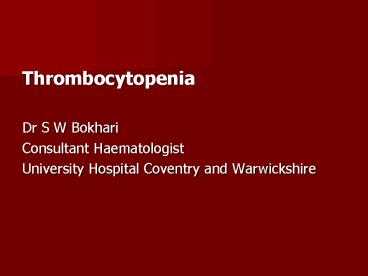Thrombocytopenia - PowerPoint PPT Presentation
1 / 34
Title:
Thrombocytopenia
Description:
Thrombocytopenia Dr S W Bokhari Consultant Haematologist University Hospital Coventry and Warwickshire Thrombocytopenia You are the Surgical HO asked to clerk patient ... – PowerPoint PPT presentation
Number of Views:799
Avg rating:3.0/5.0
Title: Thrombocytopenia
1
- Thrombocytopenia
- Dr S W Bokhari
- Consultant Haematologist
- University Hospital Coventry and Warwickshire
2
Thrombocytopenia
- You are the Surgical HO asked to clerk patient on
ward pre-operatively prior to hernia repair. - You notice from results on CRRS that his platelet
count one week earlier was 25. No previous
results. - How do you approach this problem?
3
- Repeat FBC
- Hb 13g/dL WCC 8 Neuts 2.5 Plts 28 MCV 102
- Ask for blood film to be reviewed
- Film comment confirmed thrombocytopenia, normal
- platelet morphology mild macrocytosis no other
abnormal - features
- Inform surgeons/theatres etc
4
Peripheral blood film
5
Platelet clumping
6
History
- 40 year old man
- Symptoms
- Bleeding history severity and duration
- Recent illness including infections esp. viral
- Patient had noticed easy bruising for previous 2
months. - Fit and well with no recent illness
7
Mucosal bleeding
8
Purpura
9
Past Medical History
- Infections bacterial, viral, fungal
- Autoimmune disease
- Liver disease
- Malignancy
- Occasional backpain
- Road traffic accident 5 years ago following which
he - received blood transfusion
10
Family History
- Congenital causes of thrombocytopenia
- Autoimmune disease
- Mother IDDM
- Sister recently diagnosed with SLE
11
Drug History
- Long list to consider!
- -immune-mediated
- -direct effect on BM or MK
- Alcohol intake
- Takes diclofenac for backpain
- 30 units alcohol per week spirits
- Smokes 15/day
12
Social History
- Occupation - ? Exposure to toxic agents
- Dietary history
- Recent travel abroad infections
- Risk factors for HIV
- Recently made redundant having previously worked
in - motor industry
- No recent travel abroad
- No risk factors for HIV
13
Examination
- Bleeding/bruising
- Anaemia
- Clubbing/jaundice (other features of CLD)
- Lymphadenopathy
- Signs of malignancy
- Hepatomegaly
- Splenomegaly
- Features associated with congenital causes esp.
Fanconi - anaemia
14
- Bruising over arms and legs
- ? Yellow sclera
- Liver palpable 3cm
- No other findings
15
Investigations
- FBC
- Pancytopenia or isolated thrombocytopenia
- MCV
- Blood film
- Confirm thrombocytopenia
- Platelet size and morphology
- Red cell fragments
- Red cell abnormalities e.g. target cells
- WBC features
16
Giant platelets
17
Red cell fragments
18
Target cells
19
Hypersegmented neutrophil
20
- Hb 13g/dL WCC 5 Neuts 2.0 Plts 28 MCV 102
- Target cells and stomatocytes
21
- Renal function
- Liver function
- B12 and folate
- Full clotting screen
- Normal renal function
- AST 160 Alk phos 170 ALT 130 Bili 60 ?GT 100
- B12 110 Folate 1.4
- PT ratio 1.6 APTT ratio 1.4 Normal fibrinogen and
TT
22
- Autoantibody screen specific autoantibodies as
indicated - Antiphospholipid antibodies
- Lupus anticoagulant
- Anticardiolipin antibodies
- Autoantibodies screen negative
- Antiphospholipid antibodies positive
23
- Virology testing
- EBV, CMV, toxoplasma
- Hep B, C
- HIV
- Hepatitis C positive
- Presumed secondary to blood transfusion
24
Causes of thrombocytopenia
- Failure of production
- Increased consumption/destruction
- Abnormal pooling - splenomegaly
25
Failure of production
- Congenital
- Fanconi anaemia, TAR (thrombocytopenia with
absent - radii), Wiskott-Aldrich syndrome, Bernard-Soulier
synd., - May-Hegglin anomaly, Alport synd. variant, Grey
platelet - synd.
- Acquired specific thrombocytopenia
- Infection esp. viral
- Nutritional deficiency B12/folate
- Toxic effect of drugs (more often immune) or
alcohol
26
Failure of production
- Acquired as part of bone marrow failure
- Drugs including chemotherapy
- Radiotherapy
- Marrow infiltration malignant/non-malignant
- Aplastic anaemia
27
Bone marrow aspirate
28
Bone marrow trephine
29
Increased destruction of platelets
- Immune
- Idiopathic
- ITP (acute and chronic)
- Secondary
- Autoimmune disease e.g. SLE
- Infections e.g. HIV, Hepatitis C
- Drugs e.g. heparin (HIT), quinine, quinidine,
gold salts - Lymphoproliferative disease e.g. CLL
- Neonatal alloimmune thrombocytopenia
- Post-transfusion purpura
30
Increased destruction of platelets
- Non-immune
- Microangiopathic haemolytic anaemia (MAHA)
- DIC
- HUS
- TTP idiopathic or 2º e.g. pregnancy,
infection, metastatic carcinoma, drugs, BMT, AI
disease - Pregnancy related
- Gestational thrombocytopenia
- Preeclampsia
- HELLP
31
Management
- Few spontaneous bleeding problems if plts gt 30
- Unless
- Abnormal platelet function
- Associated coagulopathy
- In general patients need treatment if symptomatic
or increased risk of bleeding e.g.
peri/post-operatively, trauma, obstetric - In general would want platelets gt 50 for minor op
and gt80/100 for major op. - May need to transfuse plts if count higher but
abnormal function
32
Management
- May need bone marrow to determine whether cause
of thrombocytopenia is failure of production or
increased destruction - Stop any possible implicated drugs
- In general if failure of production
- Platelet transfusions
- Treat underlying cause e.g. B12/folate
replacement
33
Management
- In general if increased destruction
- Avoid platelet transfusions as these are often
ineffective and can make clinical situation worse
e.g. TTP, HIT - Exception - DIC
- May be required if life-threatening bleeding
e.g. ITP - Treat underlying cause e.g. CLL
- ITP
- Immunosuppression steroids, IVIG, other
immunosuppressive agents - Splenectomy
34
Management
- TTP-HUS may require plasma exchange/FFP
- NAIT/PTP may require HPA1A neg plts

